This is a classical French-style recipe for homemade beef stock. It’s vastly superior to any store-bought stock, and is one of the main things that distinguishes home and restaurant cooking.
It takes time to make, but if you truly want the best, it’s worth it!
More stocks: chicken stock | vegetable stock

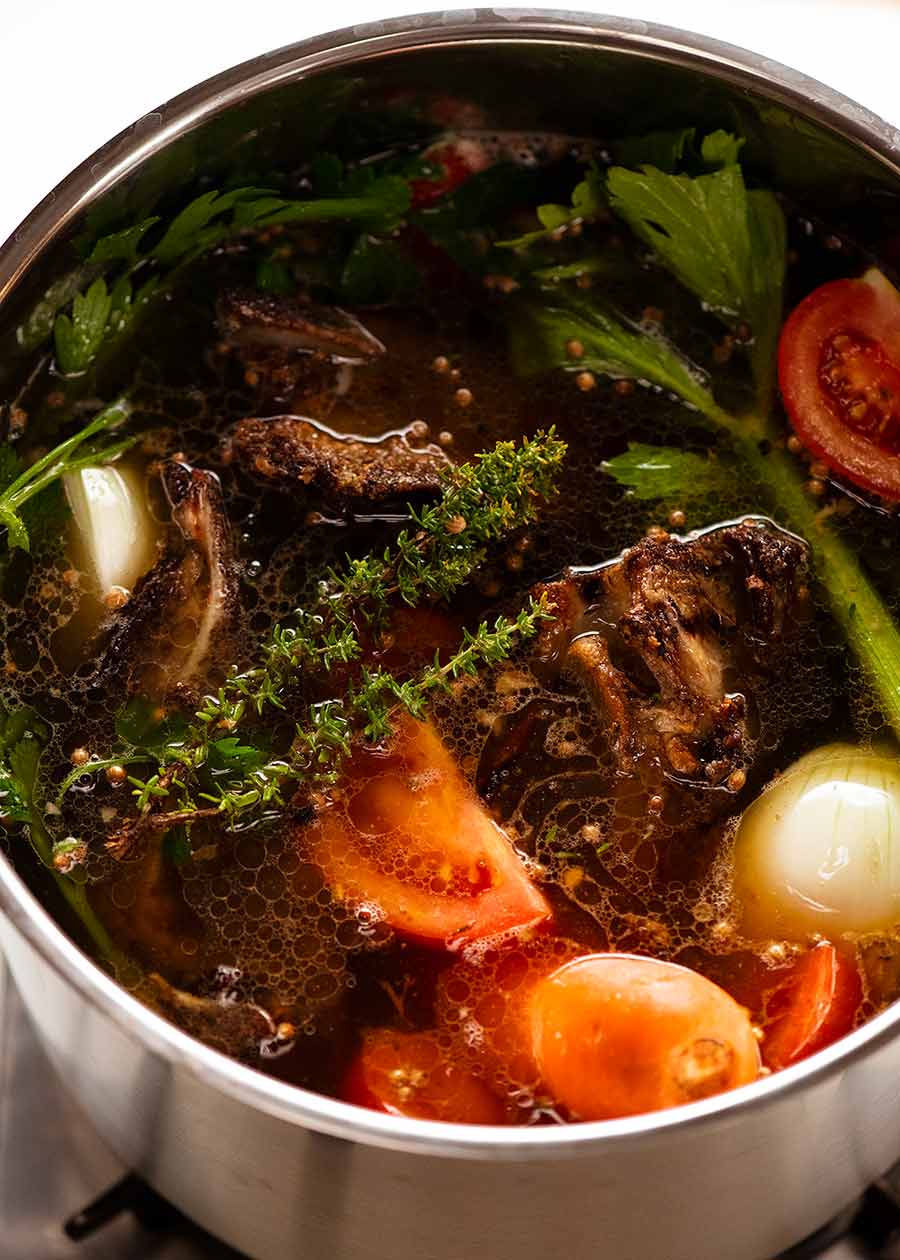
Let me say from the outset: homemade beef stock requires effort. It takes time – I’m talking minimum 4 hours, up to 10 hours is best – there’s a pile of hot bones to discard, and big cooking vessels that’ll need cleaning.
So one might ask:
Why make beef stock at home?
Because it is so vastly superior to any store-bought stock. While I think that (most) store bought chicken stock is actually pretty good these days and vegetable stock is passable, beef stock has never been that great.
Homemade beef stock has:
Far better flavour – Store bought stock does not compare to real, freshly made stock. A simple taste is all it takes to confirm this;
Richer mouthfeel – Gelatin from the bones and connective tissue in beef bones is what gives a stock its full-bodied richness and mouthfeel when used in soups and stews etc, as well as natural thickness when highly reduced for use as a jus or in sauces. Store-bought stock lacks this quality;
More versatile because it’s unsalted – Store-bought stock is almost always salted. This is fine when used at normal concentrations, but if stock is reduced a lot when making ragus, sauces and so on, the salt can become excessive – yet there is little you can do about it. Homemade stock on the other hand is unsalted, so you will never have this problem and can control seasoning in the finished dish; and
Cheaper than high quality store-bought stocks. Yes, regular supermarket packet beef stock (eg. Campbell’s) is cheaper than homemade stock. But it also tastes quite artificial, because producers are yet to successfully mass-produce cheap beef stock to a decent level of quality. High-end packaged stocks are better, but are very expensive by comparison.
Homemade stock is one of the big things that differentiate home and restaurant cooking. Good restaurants always make their own stocks, and is the secret to why their dishes often have that richer, deeper, “restaurant-quality” taste to them.

What goes in homemade beef stock
The key ingredient to make a really good beef stock is meaty bones. No meat, no flavour!
You need 2 1/2 kg / 5 lb of beef bones to make 1 1/4 – 1.5 litres / quarts of stock (5 – 6 cups).


In addition to bones, we also want aromatics which add character, deepen the flavour, add a touch of sweetness and also provide some colour. Here’s what I use:

Bay leaves, thyme, parsley, black peppercorns – Herb and spice aromatics, fairly standard;
Onion, celery and carrot – Again, familiar building-block ingredients in the stock which add subtle sweetness and flavour;
Tomato – Something you don’t see in the most basic beef stock recipes, this adds a touch of sweetness and colour, deepening it to a desirable rich dark brown;
Cider vinegar – A great cheffy touch, a little vinegar helps extract nutrients out of the bone into the broth;
Coriander seeds – Another little cheffy tip, it adds another layer of subtle complexity to the finished stock. You can’t separately identify the flavour, but a little taste is all it takes to know you’ve made something special!
Though it takes hours and the manhandling of a (very!) large stock pot, it’s actually very straightforward to make this beef stock. Also, the nice thing about this beef stock recipe is that there are 3 ways to do the slow simmer part:
On the stove, the traditional way;
Oven – Entirely hands off, I’ve even done it overnight; or
Slow cooker – Assuming you have one large enough.
How to make beef stock

Spread bones out on tray to roast. Roasting develops lots of flavour as well as darkening the colour of the stock;
Roast bones for 1 hour at 180°C/350°F, turning halfway, until nicely browned all over;
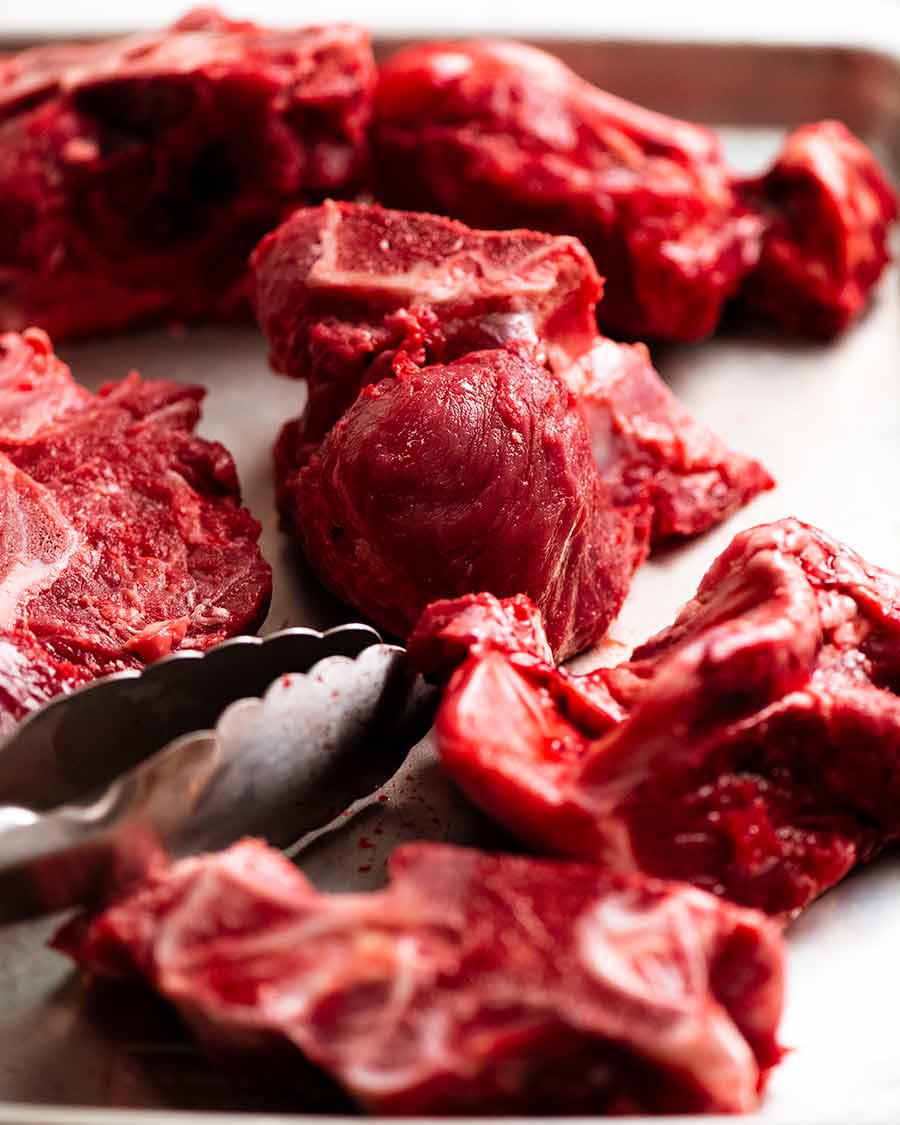
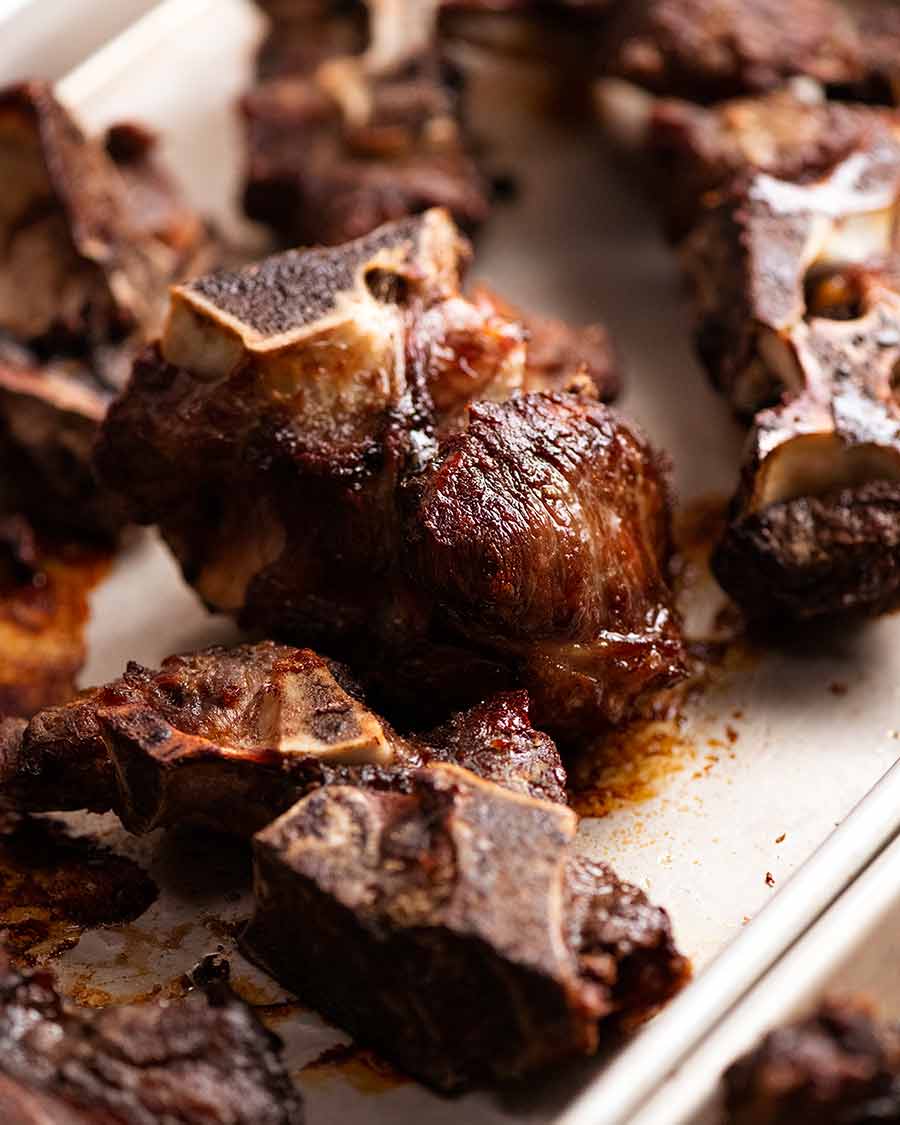

Place beef bones in a very large stock pot, at least 7 litres / quarts;
Add the herbs and vegetables, and 3 litres of water to just cover the bones. Pack the bones and vegetables down so you minimise the amount of water required. Nobody wants to end up with a watery beef stock!


Deglaze the pan – don’t waste the precious drippings on the tray, it’s free flavour! Pop the tray on the stove, add a splash of water, and as it simmers the drippings will dissolve into the water. You could also do this in the oven;
Scrape pan juices into the pot;

3 – 8 hour simmer on stove – Simmer stock on the stove, for a minimum of 3 hours and ideally up to 8 hours. Stove is the traditional method, and it’s entirely hands-off. The heat should be so low that you only get a little bubble every once in a while, and it doesn’t need stirring. Do not simmer or boil to try to speed things up, it will make the stock cloudy.
If you do the faster, 3 hour simmer … If you choose this option, which we often deploy because there aren’t many times when I can have a pot of stock simmering away all day, we simmer on a marginally stronger heat level to reduce the water faster. In addition, we reduce the stock to concentrate the flavour after straining it.
The flavour difference between 3 and 8 hours? Well, of course an 8 hour simmer yields a better result. But practicality comes into play here, and while the extra 5 hours does produce an even better result, a 3 hour simmer will still give you an exceptional stock;
Oven or slow cooker option: Alternatively, you can cook it in the oven for 8 hours or even overnight (my record is 15 hours – it was a magnificent batch!!), OR in the slow cooker for 8 hours on low.
This is what the stock water level looks like after 8 hours on the stove. The water level should reduce from around the 5.75 litres / quarts mark to around 4 litres (noting this is counting the bones etc still in the water):

Straining, storage and using
Once the stock has reduced, it’s a matter of straining, discarding excess fat then storing for use!

Strain – Fish out bones, then strain stock through a fine mesh colander / strainer into a large bowl or clean pot;
Yield: ~ 1.3 – 1.6 litres/quarts – Let the vegetable matter sit there in the strainer for a few minutes to extract as much liquid as possible. You should have around 1.5 litres / quarts of liquid. After discarding the excess fat (later step), there should be around 1.25 litres / quarts of stock;
Cool rapidly by sitting the uncovered pot in a sink full of cold tap water. Change the water every 20 minutes or so as it heats up, and it should take around 1 hour 15 minutes to cool to room temperature (around 21°C/70°F).
It’s important to cool rapidly to prevent bacteria from growing (they love cosy warm environments!) so we can get it in the fridge ASAP. Never put a large hot pot of stock in the fridge otherwise you will significantly raise the internal temperature of the fridge – that’s bad!
Refrigerate – Transfer to a suitable storage container – I use a jug – then refrigerate;
Remove surface fat – Once it has fully chilled in the fridge, the fat floating on the surface will solidify into a white mass. Use a large, flat spoon to carefully scrap it off and discard.
This is what beef stock looks like when chilled and the fat has been removed. It solidifies into a jelly because of the gelatin. Gelatin is what gives the stock that fine-dining restaurant, rich mouthfeel. Store bought stock is always liquid because it has little gelatin.

Done! Your stock is now done and ready for use! It will keep in the fridge for 7 days (I’ve been told by a reliable source 10 days is ok, but I say up to 7 to err on the side of caution). Else, it can freeze for up to 3 months.
I like to store stock in 1- or 2-cup portions, labelled, in the freezer.

How to use homemade beef stock
To use homemade beef stock, you can either reheat in the microwave or on the stove to return it to a liquid so it can be measured out. It melts very quickly – literally in a minute or two.
It can be added straight into dishes in cold jelly form too. For me, it’s just a question of whether I need to measure it or not – it’s harder to accurately measure out jelly!

What to use homemade beef stock for
Use homemade beef stock for any recipe that calls for beef stock or beef broth. Your finished dish will be multiple times better than any version made using store bought, with a far richer, deeper flavour and none of that undesirable artificial edge that store bought beef stock has.
You will gain exceptionally good results when used especially in slow-cooked dishes such as stews, as well as soups, sauces and gravies (plain or mushroom!).
Here are some suggestions:
IMPORTANT: Salt adjustment when using!
The only thing to note with homemade stock is that you will need to add more salt to whatever dish you’re making. This is because most recipes – including mine – presume store-bought beef stock. Store-bought stock is salted, whereas home-made is unsalted. Therefore, you need to compensate for this difference.
As a rule of thumb, you will need to add 1/3 teaspoon of cooking or kosher salt for every 1 cup of homemade beef stock in order to have the same level of salt as low sodium store bought stock.
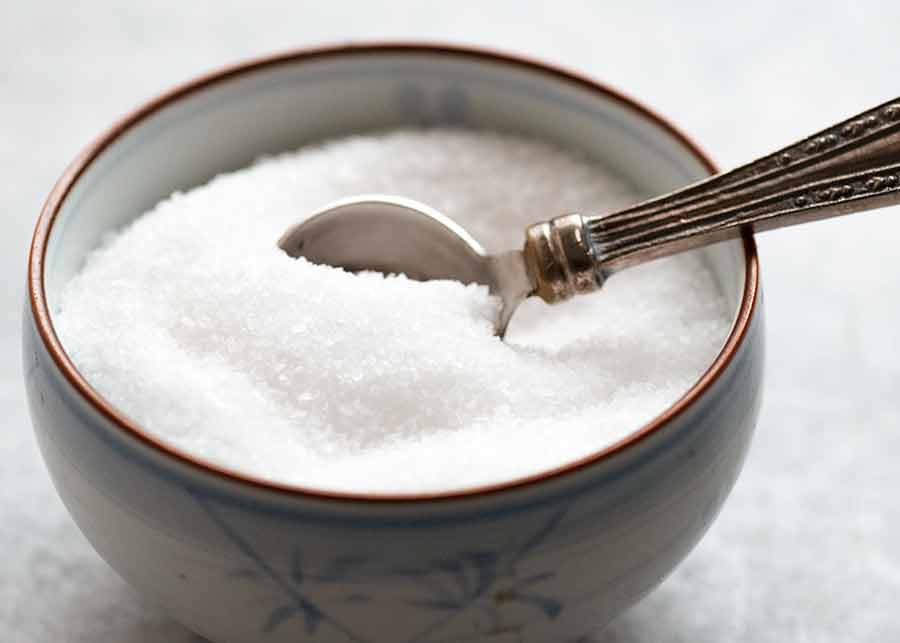

And with that, I’m done! The first of a series of homemade stocks that I plan to share.
Next up, fish stock! – Nagi x
Watch how to make it
Hungry for more? Subscribe to my newsletter and follow along on Facebook, Pinterest and Instagram for all of the latest updates.
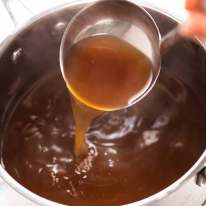
Homemade beef stock recipe
Ingredients
- 2.5 kg / 5 lb meaty beef bones , back and neck preferably, plus one marrow bone for richness (or knuckles) (Note 1)
- 1 carrot , unpeeled, cut in half
- 1/2 onion (brown or yellow), peel and cut in half
- 2 tomatoes , cut into quarters (keep seeds in) (Note 2)
- 1/2 tbsp coriander seeds (Note 2)
- 1 tbsp apple cider vinegar (Note 3)
- 1/2 tbsp black peppercorns
- 1 celery stem , cut in half or thirds (leaves on ok)
- 2 bay leaves , fresh (or 1 dried)
- 2 thyme sprigs (or 1/2 tsp dried leaves)
- 12 parsley sprigs , if you have it (not essential)
- 3 litres/quarts water , cold tap water
Instructions
Roast bones:
- Preheat oven to 220°C/430°F (200°C fan).
- Spread bones out across 2 baking trays. Roast for 1 hour, turning at 30 minutes, or until very well browned.
- Drain and discard excess fat, if any.
- Place bones into large stock pot (7 litres/7 quarts+ capacity)
Deglaze trays:
- Place tray on stove, turn onto medium. Add 3/4 cup water. When it comes to a simmer, start scraping the tray. The drippings (fond) on the tray will loosen and dissolve into the liquid.
- Once most of the drippings are removed from the base, scrape all the liquid into the pot. Repeat with other tray.
Simmer stock:
- Add remaining ingredients into the pot. Start with 3 litres of water, then squish the bones etc down to fit snugly in the pot. Add more water if needed, to just cover the bones (ingredients will collapse a bit as stock cooks). The water quantity depends on shape of bone and pot – my water level came to 5.75 litres/quarts mark on pot.
- Boil then simmer: Bring to a boil on medium high, then turn down to low so it's simmering ever so gently, with only a small bubble bursting every now and then.
- Remove surface scum: Scoop off any surface scum using a ladle and discard.
- Simmer for 8 hours on very low, no lid. Liquid level should reduce to around 4 litres/quarts for all – if not, just reduce after straining (Step 3 under Strain & Finish).
- Other methods: – Stove 3 hours on medium-low (very gentle simmer, with lid cracked)– oven (lid on) for 8 to 10 hours at 120°C/250°F (100°C fan). Water level will only reduce by about 500ml / 0.5 qt. Strain then rapid boil to reduce to 1.5 lt / 1.5 qt. – slow cooker 8 to 10 hours on low. Reduce after straining to 1.5 lt / 1.5 qt.
Strain & finish:
- Strain: Fish out most bones. Strain stock with remaining vegetables through a fine mesh colander / strainer set over a large pot or bowl. Leave strainer for a few minutes to let it drip.
- Cool to room temperature: Set stock pot or bowl in sink filled with cold water. Leave stock to cool for around 1h 15 mins, changing water every 20 mins or so as it gets warm.
- Measure stock volume: Pour stock into a vessel to measure volume – it should be between around 1.3 – 1.7 litres/quarts. If it's much more, reduce on the stove, otherwise stock flavour will be too weak.
- Refrigerate stock. When fat has solidified on surface, carefully scrape off with a large spoon and discard. You should have 1.25 – 1.5 L/Qts remaining.
- Ready! Beef stock is now ready to use! This stock is equivalent in strength to store-bought stock, so it can be used 1:1 in any recipe calling for beef stock.
- Salt adjustment: Homemade stock is unsalted whereas store-bought stock is salted. Add 1/4 tsp salt for every 1 cup homemade beef stock (250ml) to match the salt level of store-bought low sodium beef stock.
- To use: Cold stock has a jellied consistency (Note 4). It takes barely a minute to turn liquid on a medium high stove, or microwave. You can also just add it in jelly form straight into dishes, but sometimes you may need to liquify it to measure.
Recipe Notes:
- Very low stove for 8 hours with the lid off should get close to the target liquid quantity – 4 litres / 4 qts with the bone in, 1.3 – 1.7 litres/quarts after straining;
- Medium low stove for 3 hours with the lid cracked should also get to the target stock quantity;
- Oven for 8 – 10 hours will only reduce about 500ml / 0.5 qt so it will need to be rapid boiled after straining; and
- Slow cooker will barely reduce at all so will need to be reduced.
Nutrition Information:
Life of Dozer
Dozer agrees that meaty bones are best.
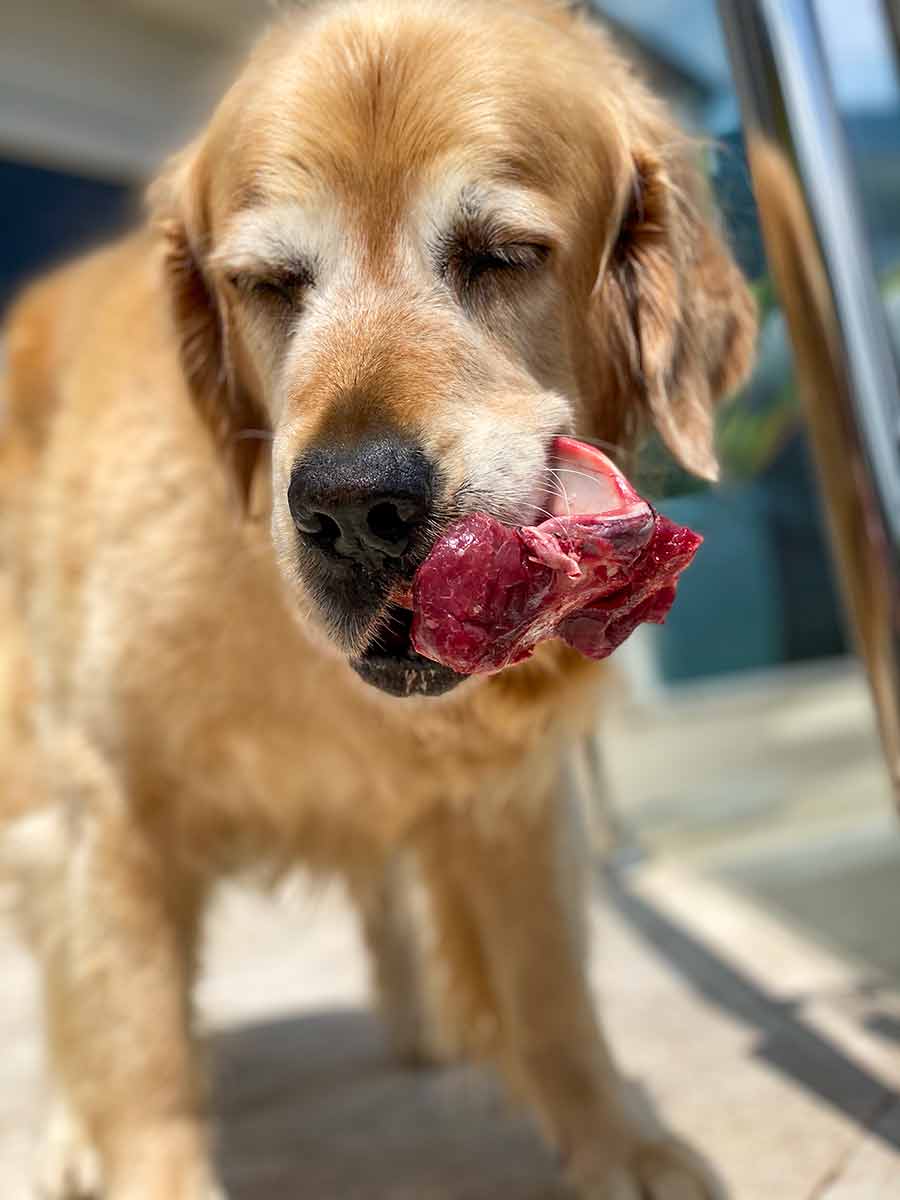







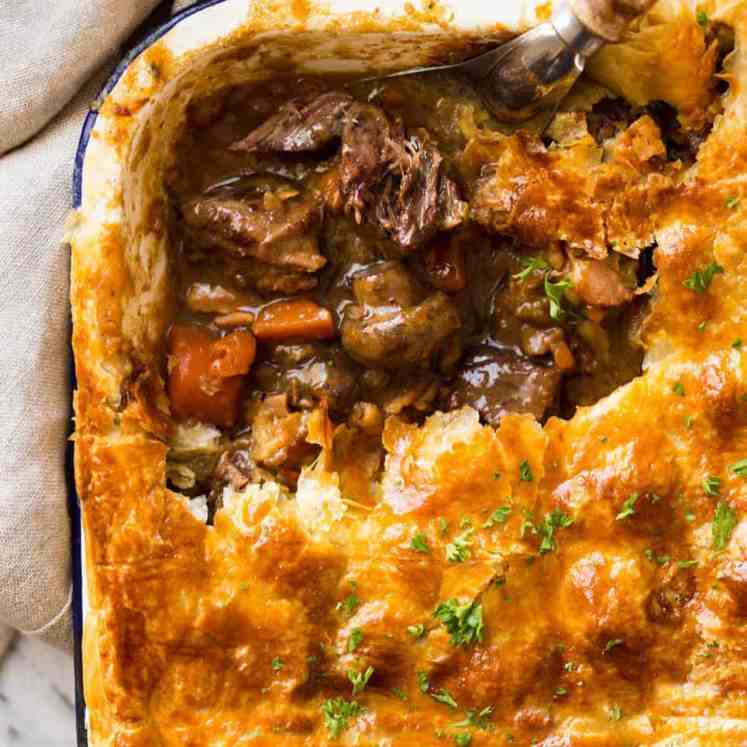

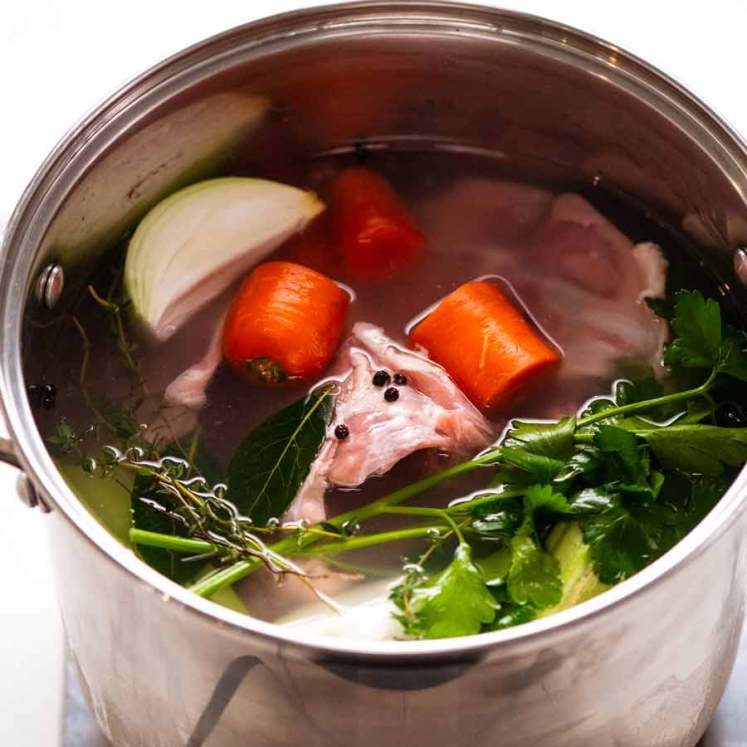

vaticancatholic.com
excellent! And my apartment smelled wonderful:)
vaticancatholic.com
D-LISH!! Second time making this bone broth and this will always be my “Go-To” recipe for it!
Hello,
I have bones that don’t have much meat on them. Is it possible to add pieces of beef, like cubed stew beef, to add flavor? I can’t wait to try this recipe!!!
Hi Nagi, I had left over steak bones and I didn’t want to waste them so I attempted to make stock using your recipe. It turned out great. I was pretty amazed to see how much fat came out of the bones when roasted. I also loved how putting the pan on top of the boiling soup lifts the flavors from the bottom of the pan. I also admire you for helping people with your prepared food meals. Thank you for sharing your recipes.
Hi Nagi, I’ve been making my own stock for many years and learnt a lot from my son, a chef in fine dining. But only now am I researching the difference between stock/ broth! Thank you so much for all your amazing recipes! They ALWAYS turn out so very well! Your site is my first to go to when I’m cooking for guests!
Could we not clarify the fat for use in Yorkies?
Without a doubt, the best beef broth recipe I have ever tried! I can’t wait to use it in all my recipes that call for beef stock. It is so dang flavorful, thanks so much for sharing this!
Really delicious! I often make chicken stock but this was my 1st time doing beef stock. It was truly better than the chicken stock, which is amazing since we call r chicken stock “liquid gold”. Used some soup bones from the freezer & followed recipe almost exactly. Tasted like a delicious french onion soup base. Thank u!!
I made this for beef bourguignon and it turned out fantastic! I don’t want the rest of the broth to go to waste so is it possible to make a Pho broth with the leftover portion?
Hi Nagi, going to try this beasty recipe as fed up of using drab flavourless stock cubes n packets.
Could you add beef marrow bones into the mix or would it add too much natural gelatin to the stock.
Thanks
Sid
Hi what do you mean by 1-1 ratio? 1 cup of stock for 1 cup of water? Example please. Does this mean if a recipes calls for 2 cups of beef stock I need to only use 1 cup of this with one cup of water? Thanks
She means if a recipe calls for 1 unit of stock (say 1 cup) you can use 1 unit of this homemade stock as it has the same strength as store bought stock I.e 1:1 ratio.
Note however this doesn’t apply to the sodium content. If you want the sodium content to match day ‘low sodium’ stock you need to add 1/4 tsp of salt for every 250 ml of stock.
To make a lamb stock, would you do the same (with lamb bones) or make other changes?
Hi Nagi my idol in cooking, thank you so much for always sharing your recipe really2x appreciated.
Hi there, I’ve just finished making this fabulous stock. I increased the aromatics since I had more bones. I used marrow bones, and threw in some chunks of the brisket I’m marinating for your beef bourguignon. This simmered overnight for 12 hrs, double strained and then reduced it down a little more, quick cool on ice then into the freezer to separate the fat. Now I’ve got the most luscious, glistening, gelatinous stock. Ready to get the beef on!!
I always make my own chicken stock and just tried your homemade beef stock and it is amazing!! After I roasted the bones, I put all the ingredients into my pressure multi cooker, simmered until I got the impieties off the top and the. pressure cooked it on high for 1.5 hours. Brilliant! My beef burgundy is going to be fantastic!
Homemade beef stock is a GAME CHANGER!!! Enjoy! N x
Hi Nagi,
I want to make both your beef and chicken stocks as your vegetable stock is amazing. When making your vegetable stock, I went by weight and ended up using quite a bit more vegetables than the quantity specified in the recipe. Both your chicken and beef stock recipes do not specify weight for the veggies. I’m tempted to use the weights specified in the veggie stock as it appears that the vegetables available to me are much smaller than what you use. What would you advise? Thanks!!!!
I brought this to a boil on my cooktop and then set on the woodstove for the rest of the day. It was the perfect slow simmer temperature without using all that propane on my cooktop! Smells so cozy in the house!! And now for the “cool quickly” part, I’ll just out outside in the -15 F degree for a bit. Thanks for a great recipe! Can’t wait to use it!
That is such a great way to cook! N x
I couldn’t get “meaty” bones… will it be fine to use plain bones or would it be a good idea to add in some stewing beef for meaty flavour?
I’m making it right now. I’ll let you know tomorrow!
Second time making this. Doubled it. FANTASTIC! Followed the recipe exactly minus the coriander (didn’t have any). Used the oven method and left it in overnight. Thanks for the clear instructions.